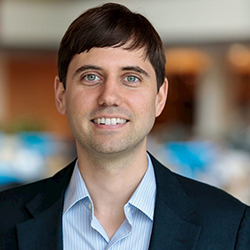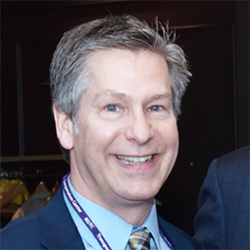During Moses Lecture, Hornbeck Challenges Traditional Estimates of Transportation Infrastructure Value
Economist Richard Hornbeck spoke at Northwestern’s 2025 Leon N. Moses Distinguished Lecture in Transportation
To the University of Chicago’s Richard Hornbeck, transportation infrastructure does far more than speed up the movement of goods. It can reshape economic activity and deliver growth that traditional models dramatically understate.
“In this distorted world, transportation infrastructure can have a bigger gain for the aggregate economy than what you would get starting from an efficient benchmark,” Hornbeck said.

Hornbeck, the V. Duane Rath Professor of Economics at the University of Chicago’s Booth School of Business, delivered the seventh Leon N. Moses Distinguished Lecture in Transportation. His Nov. 5 talk, “Amplified Gains from Transportation Infrastructure Investments,” used the historical expansion of the US railroad network in the late 1800s to illustrate how economists have long underestimated the broad effects of major infrastructure projects.
Hosted by the Northwestern University Transportation Center (NUTC), the annual lecture honors the late Professor Leon N. Moses, a former NUTC director and renowned researcher of transportation economics and regional science. Ian Savage, associate chair of the department of economics at the Weinberg College of Arts and Sciences, introduced Hornbeck.
Infrastructure can unlock hidden economic growth
Hornbeck highlighted that economic growth can come not just from innovation but also from better use of productive inputs where distortions keep firms small. Infrastructure, by connecting firms to new markets or cutting shipping costs, often achieves this in ways innovation alone cannot.
“It is very hard to actually improve technology,” Hornbeck said. “But we can actually get really substantial aggregate productivity growth not through technological innovation but through infrastructure when the economy is distorted.”
Hornbeck argued that older methods, including Robert Fogel’s “social savings” approach, rely on assumptions that don’t hold. Traditional estimates of benefits—calculating what people would pay without the infrastructure—miss vast economic spillovers from firms operating inefficiently.
“How do we think about what the gains from transportation infrastructure are?” Hornbeck said. “Why might we think about there being much larger gains than maybe have been highlighted recently?”
The railroad example: productivity gains beyond direct returns
In Fogel’s analysis, the railroads’ contribution amounted to less than 2.7 percent of US GDP in 1890. Hornbeck said such modeling, which assumes firms and markets behave efficiently, gives a false impression of limited returns. Instead, he and coauthor Martin Rotemberg found that the indirect effects of the rail network, including how it shifted economic activity to more productive places, accounted for a far larger share of total economic surplus.
Hornbeck explained that his work accounts for distortions such as market power and financing constraints, which limit the ability of firms to expand even when their marginal return on inputs far exceeds their cost. When transportation infrastructure reduces shipping costs or expands market access, these firms can scale up in ways that generate significant additional surplus for the economy, even if they do not capture that surplus directly.
The railroad network offers a clear example. Waterways were cheap but limited, and wagon transport was costly. Between 1860 and 1900, counties gaining rail access saw manufacturing and land values rise, though gains were uneven—some regions benefited while others lost relative economic strength.
Hornbeck and Rotemberg used digitized 19th-century census records to measure manufacturing output, materials use, capital stock, labor and revenue at the county level. Their framework allowed them to calculate how much more productive counties became as transportation access improved. They then simulated what would happen if the railroads were removed, leaving only waterways, canals, and wagon routes. According to their findings, the loss of the railroad network would have cost the US economy productivity equivalent to roughly 27 percent of GDP.
Hornbeck said that figure does not mean GDP itself would have fallen by 27 percent, but rather that the economic surplus associated with expanded market access was that large relative to GDP. He also emphasized that the railroad companies captured only a fraction of that value.
“For every $100 of capital the railroad companies were investing, it was generating $48 for overall US society,” he said.
NUTC Hosts Fall 2025 Workshop Spotlighting Practical Autonomous Transportation
On Nov. 5, the NUTC hosted the Fall 2025 Industry Technical Workshop. The event, “Autonomous Transportation Services Take the Road,” convened leading practitioners in autonomous transportation for a focused workshop designed to bridge cutting-edge research with frontline industry deployment.
The session brought together companies operating autonomous vehicles, autonomous trucking technologies, and emerging autonomous rail systems—each already active in practical environments.

Bret Johnson, interim director of the NUTC, said one of the center’s primary goals is ensuring researchers—especially emerging scholars—have visibility into actual technological deployment. The industry seminars play a prominent role in that mission.
“We just want to be able to get closer to some of these companies and understand what’s going on with real-world applications,” he said. “Having some insight into real-world applications helps both the faculty and the students add context and perspective to the research work they’re doing.”
The presenters at this event were Tom Baroch, the senior director of strategic partnerships at Waabi; Jay Campbell, Uber’s head of product for autonomous mobility and delivery; CJ King, chief technology officer at Torc Robotics; and Harry Zander, chief operations officer at Intramotev. A panel discussion was moderated by Alireza Talebpour, an associate professor at the University of Illinois Urbana-Champaign’s Grainger College of Engineering.